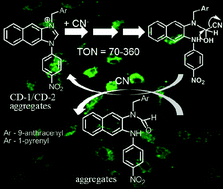A catalytic chemodosimetric approach for detection of nanomolar cyanide ions in water, blood serum and live cell imaging†
Abstract
Naphthimidazolium based monocationic chemodosimeters CD-1 and CD-2 undergo cyanide mediated catalytic transformation in the presence of cyanide ions (0.01% to 1% of CD-1/CD-2 concentrations) with a turnover number from 70 to 360. These chemodosimeters can detect as low as 0.5 nM and 1 nM cyanide ions under nearly physiological conditions (HEPES buffer–DMSO (5%), pH 7.4). The structures of CD-1 and its cyanide induced hydrolyzed product 4 have been confirmed by single crystal X-ray crystallography. CD-1 can also be used for the determination of 2 nM cyanide in the presence of blood serum. CD-1 and CD-2 also find applications in live cell imaging of 10 nM cyanide ions in rat brain C6 glioma cells. To the best of our knowledge, this is the first report where high sensitivity towards cyanide ions has been achieved through catalytic hydrolysis of the fluorescent chemodosimeter.


 Please wait while we load your content...
Please wait while we load your content...